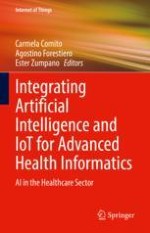The book covers the integration of Internet of Things (IoT) and Artificial Intelligence (AI) to tackle applications in smart healthcare. The authors discuss efficient means to collect, monitor, control, optimize, model, and predict healthcare data using AI and IoT. The book presents the many advantages and improvements in the smart healthcare field, in which ubiquitous computing and traditional computational methods alone are often inadequate. AI techniques are presented that play a crucial role in dealing with large amounts of heterogeneous, multi-scale and multi-modal data coming from IoT infrastructures. The book is intended to cover how the fusion of IoT and AI allows the design of models, methodologies, algorithms, evaluation benchmarks, and tools can address challenging problems related to health informatics, healthcare, and wellbeing.
